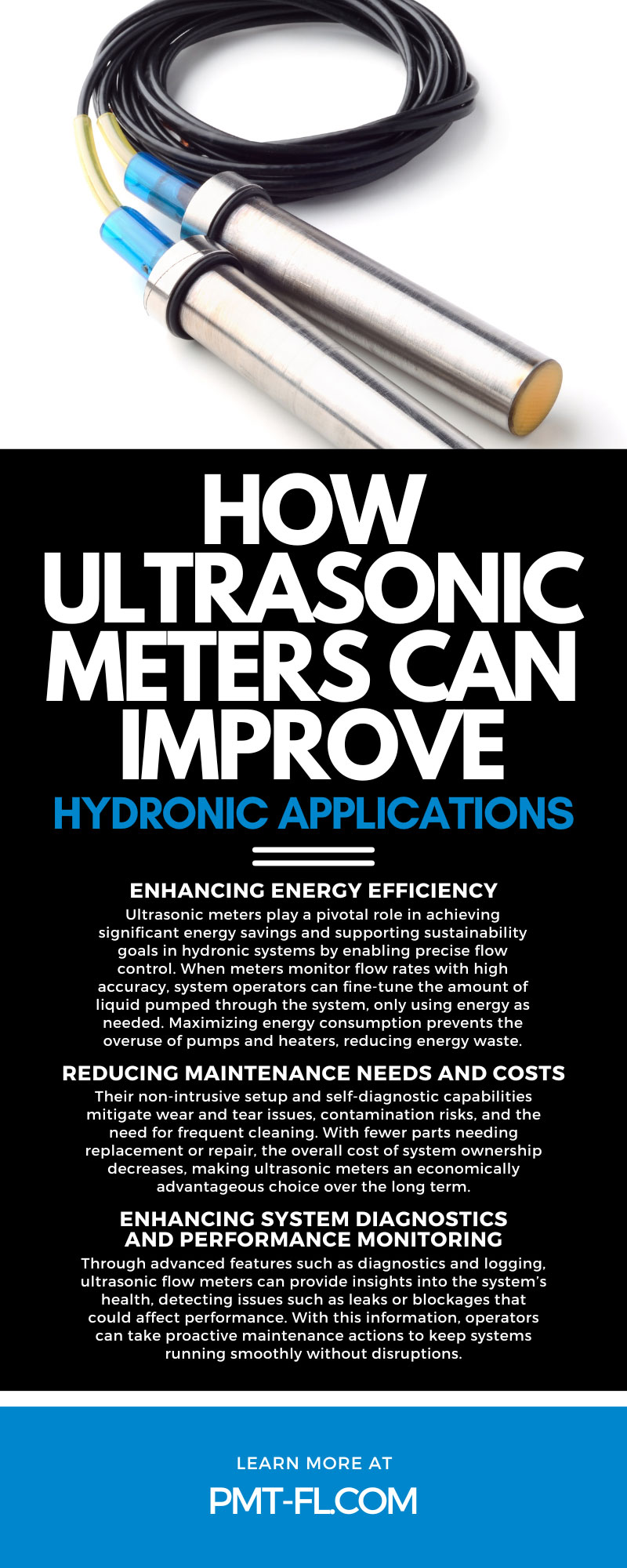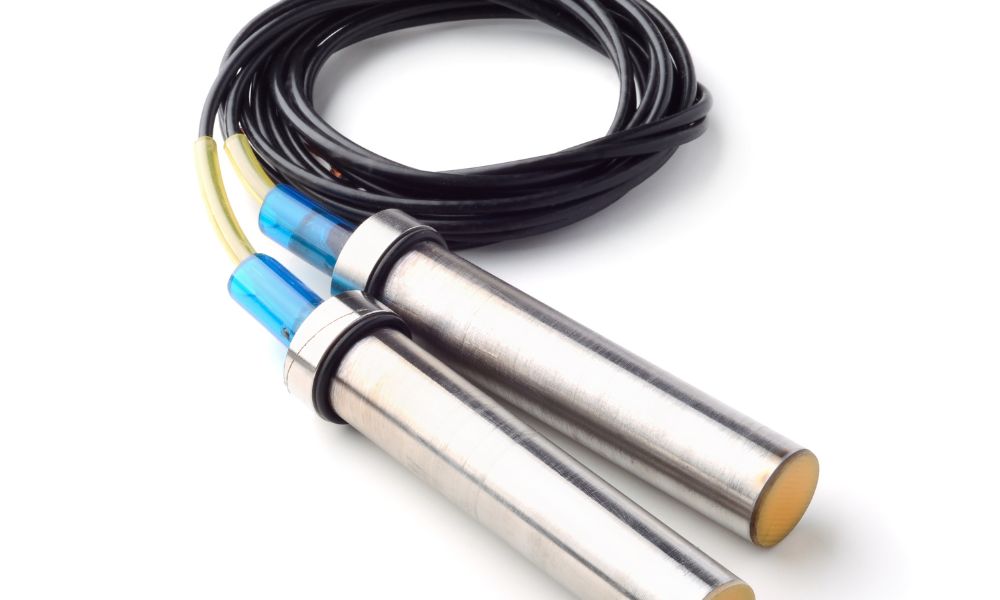Hydronic systems underpin the operations of numerous industries by transferring energy using water as a thermal medium. Their versatility is unmatched, from heating and cooling in commercial buildings to industrial process control. The efficacy of these systems hinges on the precision of flow measurements.
Precision is paramount in hydronic systems where even the slightest flow discrepancies can lead to suboptimal performance and increased operational costs. Ultrasonic flow meters can improve hydronic applications in many ways, including elevating performance, cost efficiency, and sustainability. Maximize your hydronic applications, from domestic hot water systems to floor heating, with ultrasonic meters.
The Importance of Precise Flow Measurements
Accurate flow measurement is the backbone of efficient hydronic system operation. Precise flow monitoring influences energy consumption, system performance, and the overall comfort and satisfaction of end-users. In heating systems, an accurate flow measurement ensures that the right amount of heat reaches different parts of a building, preventing areas from being over or under-heated.
Precise flow measurement allows for early detection of system issues, such as leaks or blockages, enabling prompt maintenance actions before more significant problems arise. Taking the wrong measurements can result in costly errors, underscoring the vital need for reliable flow meters.
The Principles of Ultrasonic Flow Meters
Ultrasonic flow meters operate on the principle of using sound waves to measure the velocity of a fluid flowing through a pipe. They transmit ultrasonic sound waves between two transducers placed on opposite sides of a pipe. By measuring the time it takes for the sound waves to travel with and against the flow of the fluid, the meter can precisely calculate the flow rate. This method, known as the time-of-flight or transit time difference method, is highly accurate and reliable for both liquid and gas measurements.
Types of Ultrasonic Flow Meters
Ultrasonic flow meters come in varying forms. Two of the most popular types of ultrasonic flow meters include inline and clamp-on. Inline meters are integrated into piping systems, offering direct contact with the fluid for measurement. Clamp-on flow meters, on the other hand, are on pipe surfaces, making them non-intrusive and easy to install without disrupting the flow. Their non-intrusive nature reduces the risk of contamination and pressure drop in the system.
Ultrasonic vs. Traditional Flow Meters
Ultrasonic flow meters provide a wide measurement range and maintain high accuracy across different flow rates and fluid types, which is not always the case with traditional meters. For example, the presence of a turbine in the flow path can introduce pressure drops and flow disturbances. The mechanical approach of turbines can also increase wear and tear over time, as the moving parts are subject to continuous fluid contact.
Ultrasonic meters require minimal maintenance as they have no moving parts. This feature, combined with their advanced diagnostics capabilities, makes them a superior choice for modern hydronic applications looking for efficiency, reliability, and ease of maintenance.
Enhancing Energy Efficiency
Ultrasonic meters play a pivotal role in achieving significant energy savings and supporting sustainability goals in hydronic systems by enabling precise flow control. When meters monitor flow rates with high accuracy, system operators can fine-tune the amount of liquid pumped through the system, only using energy as needed. Maximizing energy consumption prevents the overuse of pumps and heaters, reducing energy waste. In a heating system, accurate flow measurement ensures that the system delivers just the right amount of heat to maintain desired temperatures, eliminating wasteful overheating. Similarly, in cooling systems, it prevents overcooling and avoids the unnecessary operation of chillers.
Efficient energy use contributes to the broader sustainability agenda, reducing the carbon footprint of heating and cooling operations. Adopting ultrasonic meters in hydronic applications is a step forward in promoting eco-friendly practices while maintaining operational efficiency and effectiveness.
Reducing Maintenance Needs and Costs
Ultrasonic flow meters reduce hydronic systems’ maintenance costs and operational disruptions. Their non-intrusive setup and self-diagnostic capabilities mitigate wear and tear issues, contamination risks, and the need for frequent cleaning. With fewer parts needing replacement or repair, the overall cost of system ownership decreases, making ultrasonic meters an economically advantageous choice over the long term.
Fewer frequent maintenance interventions also minimize operational downtime, ensuring systems remain functional and efficient without significant interruptions. The increased reliability is crucial for buildings and facilities where consistent climate control is essential for comfort or process requirements. The reduced need for manual inspections and maintenance activities subsequently enhances the safety of maintenance personnel, minimizing their exposure to potentially hazardous conditions.
Enhancing System Diagnostics and Performance Monitoring
Beyond measuring flow, ultrasonic meters can offer valuable data for system diagnostics and performance monitoring. Through advanced features such as diagnostics and logging, ultrasonic flow meters can provide insights into the system’s health, detecting issues such as leaks or blockages that could affect performance. With this information, operators can take proactive maintenance actions to keep systems running smoothly without disruptions.
Ultrasonic meters are compatible with smart metering technologies, allowing remote monitoring and data analysis capabilities. Operators can maximize system performance and energy consumption in real time. With real-time data, any deviations, such as unexpected drops in flow rate or temperature anomalies, are possible to immediately identify, allowing for prompt corrective actions. Immediate responses prevent costly downtime and repairs and contribute to consistent system performance and energy efficiency.
Real-time monitoring also supports predictive maintenance strategies by identifying trends that may indicate future system failures, allowing for preemptive interventions. Real-time data collection transforms hydronic systems into dynamic, self-correcting entities that maintain peak performance while minimizing energy use and operational costs.
The Future of Ultrasonic Flow Meters
The future of ultrasonic flow meters includes advancements aiming to boost accuracy, reliability, and applicability. AI integration can enhance precision and diagnostic capabilities, potentially leading to self-calibrating systems and more efficient flow analysis, reducing the need for human intervention. As IoT-connected devices become more prevalent, ultrasonic flow meters are poised to play a key role in smart infrastructure, communicating in real-time to optimize performance. Advancements in materials and manufacturing techniques may also enhance durability without compromising accuracy.
Ultrasonic meters can improve hydronic systems in many ways, transforming hydronic system management and maximization. For stakeholders in industries reliant on hydronic systems, integrating ultrasonic flow meters is a strategic move toward achieving operational excellence. As this technology continues to evolve, its adoption will undoubtedly become a standard, heralding a new era of efficiency in hydronic system management. Find the right ultrasonic flow meter for your hydronic system applications with help from PMT. Contact a representative today!


